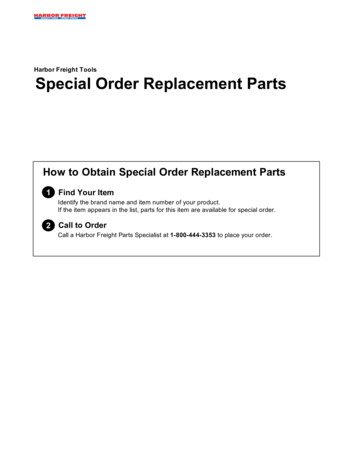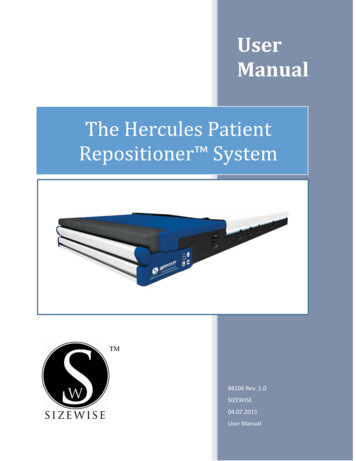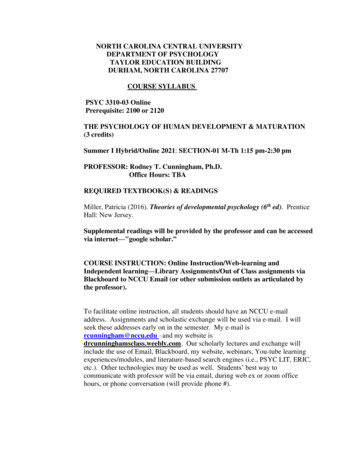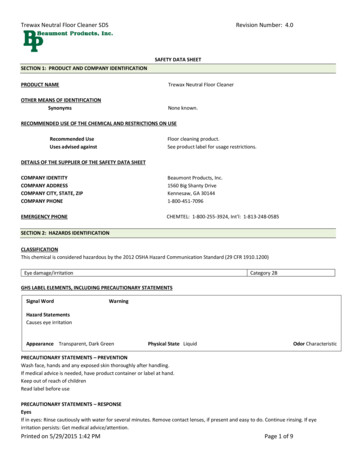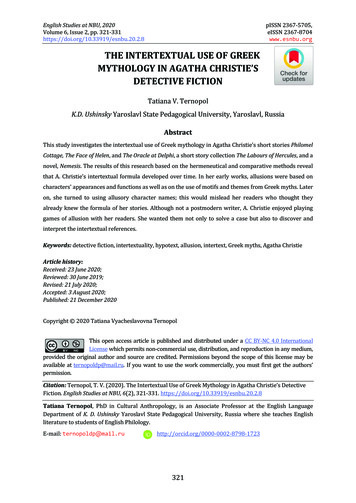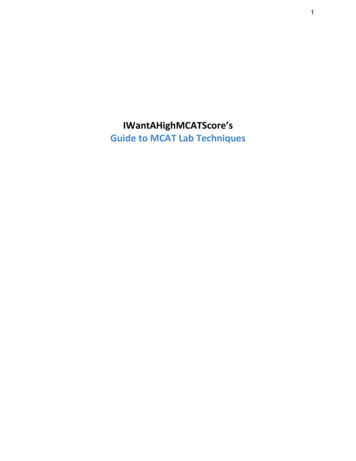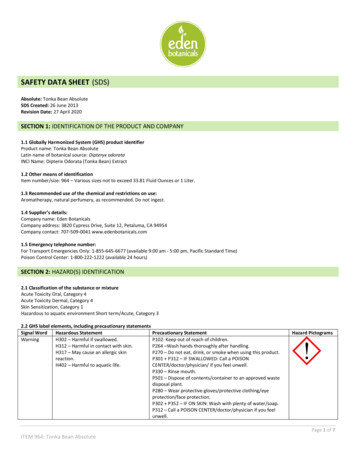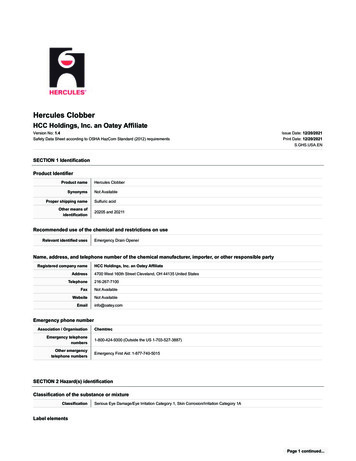
Transcription
Hercules ClobberHCC Holdings, Inc. an Oatey AffiliateVersion No: 1.4Safety Data Sheet according to OSHA HazCom Standard (2012) requirementsIssue Date: 12/20/2021Print Date: 12/20/2021S.GHS.USA.ENSECTION 1 IdentificationProduct IdentifierProduct nameSynonymsProper shipping nameOther means ofidentificationHercules ClobberNot AvailableSulfuric acid20205 and 20211Recommended use of the chemical and restrictions on useRelevant identified usesEmergency Drain OpenerName, address, and telephone number of the chemical manufacturer, importer, or other responsible partyRegistered company nameAddressTelephoneFaxWebsiteEmailHCC Holdings, Inc. an Oatey Affiliate4700 West 160th Street Cleveland, OH 44135 United States216-267-7100Not AvailableNot Availableinfo@oatey.comEmergency phone numberAssociation / OrganisationEmergency telephonenumbersOther emergencytelephone numbersChemtrec1-800-424-9300 (Outside the US 1-703-527-3887)Emergency First Aid: 1-877-740-5015SECTION 2 Hazard(s) identificationClassification of the substance or mixtureClassificationSerious Eye Damage/Eye Irritation Category 1, Skin Corrosion/Irritation Category 1ALabel elementsPage 1 continued.
Version No: 1.4Page 2 of 13Issue Date: 12/20/2021Print Date: 12/20/2021Hercules ClobberHazard pictogram(s)Signal wordDangerHazard statement(s)Causes severe skin burns and eye damage.Hazard(s) not otherwise classifiedNot ApplicablePrecautionary statement(s) PreventionDo not breathe mist/vapours/spray.Wash all exposed external body areas thoroughly after handling.Wear protective gloves, protective clothing, eye protection and face protection.Precautionary statement(s) ResponseIF SWALLOWED: Rinse mouth. Do NOT induce vomiting.IF ON SKIN (or hair): Take off immediately all contaminated clothing. Rinse skin with water/shower.IF IN EYES: Rinse cautiously with water for several minutes. Remove contact lenses, if present and easy to do. Continue rinsing.Immediately call a POISON CENTER/doctor/physician/first aider.Wash contaminated clothing before reuse.IF INHALED: Remove person to fresh air and keep comfortable for breathing.Precautionary statement(s) StorageStore locked up.Precautionary statement(s) DisposalDispose of contents/container to authorised hazardous or special waste collection point in accordance with any local regulation.SECTION 3 Composition / information on ingredientsSubstancesSee section below for composition of MixturesMixturesCAS No%[weight]Name7664-93-960-100sulfuric acidThe specific chemical identity and/or exact percentage (concentration) of composition has been withheld as a trade secret.SECTION 4 First-aid measuresDescription of first aid measuresEye ContactSkin ContactIf this product comes in contact with the eyes:Immediately hold eyelids apart and flush the eye continuously with running water.Ensure complete irrigation of the eye by keeping eyelids apart and away from eye and moving the eyelids by occasionallylifting the upper and lower lids.Continue flushing until advised to stop by the Poisons Information Centre or a doctor, or for at least 15 minutes.Transport to hospital or doctor without delay.Removal of contact lenses after an eye injury should only be undertaken by skilled personnel.If skin or hair contact occurs:Immediately flush body and clothes with large amounts of water, using safety shower if available.Continued.
Version No: 1.4Page 3 of 13Hercules ClobberIssue Date: 12/20/2021Print Date: 12/20/2021Quickly remove all contaminated clothing, including footwear.Wash skin and hair with running water. Continue flushing with water until advised to stop by the Poisons Information Centre.Transport to hospital, or doctor.InhalationIf fumes or combustion products are inhaled remove from contaminated area.Lay patient down. Keep warm and rested.Prostheses such as false teeth, which may block airway, should be removed, where possible, prior to initiating first aidprocedures.Apply artificial respiration if not breathing, preferably with a demand valve resuscitator, bag-valve mask device, or pocketmask as trained. Perform CPR if necessary.Transport to hospital, or doctor, without delay.IngestionFor advice, contact a Poisons Information Centre or a doctor at once.Urgent hospital treatment is likely to be needed.If swallowed do NOT induce vomiting.If vomiting occurs, lean patient forward or place on left side (head-down position, if possible) to maintain open airway andprevent aspiration.Observe the patient carefully.Never give liquid to a person showing signs of being sleepy or with reduced awareness; i.e. becoming unconscious.Give water to rinse out mouth, then provide liquid slowly and as much as casualty can comfortably drink.Transport to hospital or doctor without delay.Most important symptoms and effects, both acute and delayedSee Section 11Indication of any immediate medical attention and special treatment neededFor acute or short term repeated exposures to strong acids:Airway problems may arise from laryngeal edema and inhalation exposure. Treat with 100% oxygen initially.Respiratory distress may require cricothyroidotomy if endotracheal intubation is contraindicated by excessive swellingIntravenous lines should be established immediately in all cases where there is evidence of circulatory compromise.Strong acids produce a coagulation necrosis characterised by formation of a coagulum (eschar) as a result of the dessicating action of the acid on proteins inspecific tissues.INGESTION:Immediate dilution (milk or water) within 30 minutes post ingestion is recommended.DO NOT attempt to neutralise the acid since exothermic reaction may extend the corrosive injury.Be careful to avoid further vomit since re-exposure of the mucosa to the acid is harmful. Limit fluids to one or two glasses in an adult.Charcoal has no place in acid management.Some authors suggest the use of lavage within 1 hour of ingestion.SKIN:Skin lesions require copious saline irrigation. Treat chemical burns as thermal burns with non-adherent gauze and wrapping.Deep second-degree burns may benefit from topical silver sulfadiazine.EYE:Eye injuries require retraction of the eyelids to ensure thorough irrigation of the conjuctival cul-de-sacs. Irrigation should last at least 20-30 minutes. DONOT use neutralising agents or any other additives. Several litres of saline are required.Cycloplegic drops, (1% cyclopentolate for short-term use or 5% homatropine for longer term use) antibiotic drops, vasoconstrictive agents or artificial tearsmay be indicated dependent on the severity of the injury.Steroid eye drops should only be administered with the approval of a consulting ophthalmologist).[Ellenhorn and Barceloux: Medical Toxicology]SECTION 5 Fire-fighting measuresExtinguishing mediaWater spray or fog.Foam.Dry chemical powder.BCF (where regulations permit).Carbon dioxide.Special hazards arising from the substrate or mixtureFire IncompatibilityNone known.Special protective equipment and precautions for fire-fightersFire FightingAlert Fire Department and tell them location and nature of hazard.May be violently or explosively reactive.Wear full body protective clothing with breathing apparatus.Continued.
Version No: 1.4Page 4 of 13Hercules ClobberIssue Date: 12/20/2021Print Date: 12/20/2021Prevent, by any means available, spillage from entering drains or water courses.Consider evacuation (or protect in place).Use water delivered as a fine spray to control fire and cool adjacent area.Avoid spraying water onto liquid pools.DO NOT approach containers suspected to be hot.Cool fire exposed containers with water spray from a protected location.If safe to do so, remove containers from path of fire.Equipment should be thoroughly decontaminated after use.Fire/Explosion HazardNon combustible.Not considered to be a significant fire risk.Acids may react with metals to produce hydrogen, a highly flammable and explosive gas.Heating may cause expansion or decomposition leading to violent rupture of containers.May emit corrosive, poisonous fumes. May emit acrid smoke.Decomposition may produce toxic fumes of:sulfur oxides (SOx)SECTION 6 Accidental release measuresPersonal precautions, protective equipment and emergency proceduresSee section 8Environmental precautionsSee section 12Methods and material for containment and cleaning upMinor SpillsDrains for storage or use areas should have retention basins for pH adjustments and dilution of spills before discharge ordisposal of material.Check regularly for spills and leaks.Clean up all spills immediately.Avoid breathing vapours and contact with skin and eyes.Control personal contact with the substance, by using protective equipment.Contain and absorb spill with sand, earth, inert material or vermiculite.Wipe up.Place in a suitable, labelled container for waste disposal.Major SpillsClear area of personnel and move upwind.Alert Fire Department and tell them location and nature of hazard.May be violently or explosively reactive.Wear full body protective clothing with breathing apparatus.Prevent, by any means available, spillage from entering drains or water course.Consider evacuation (or protect in place).Stop leak if safe to do so.Contain spill with sand, earth or vermiculite.Collect recoverable product into labelled containers for recycling.Neutralise/decontaminate residue (see Section 13 for specific agent).Collect solid residues and seal in labelled drums for disposal.Wash area and prevent runoff into drains.After clean up operations, decontaminate and launder all protective clothing and equipment before storing and re-using.If contamination of drains or waterways occurs, advise emergency services.Personal Protective Equipment advice is contained in Section 8 of the SDS.SECTION 7 Handling and storagePrecautions for safe handlingSafe handlingAvoid all personal contact, including inhalation.Wear protective clothing when risk of exposure occurs.Use in a well-ventilated area.WARNING: To avoid violent reaction, ALWAYS add material to water and NEVER water to material.Avoid smoking, naked lights or ignition sources.Avoid contact with incompatible materials.When handling, DO NOT eat, drink or smoke.Keep containers securely sealed when not in use.Avoid physical damage to containers.Always wash hands with soap and water after handling.Continued.
Version No: 1.4Page 5 of 13Hercules ClobberIssue Date: 12/20/2021Print Date: 12/20/2021Work clothes should be laundered separately. Launder contaminated clothing before re-use.Use good occupational work practice.Observe manufacturer's storage and handling recommendations contained within this SDS.Atmosphere should be regularly checked against established exposure standards to ensure safe working conditions aremaintained.DO NOTallow clothing wet with material to stay in contact with skinOther informationStore in original containers.Keep containers securely sealed.Store in a cool, dry, well-ventilated area.Store away from incompatible materials and foodstuff containers.Protect containers against physical damage and check regularly for leaks.Observe manufacturer's storage and handling recommendations contained within this SDS.Conditions for safe storage, including any incompatibilitiesSuitable containerStorage incompatibilityDO NOTuse aluminium or galvanised containersCheck regularly for spills and leaksLined metal can, lined metal pail/ can.Plastic pail.Polyliner drum.Packing as recommended by manufacturer.Check all containers are clearly labelled and free from leaks.For low viscosity materialsDrums and jerricans must be of the non-removable head type.Where a can is to be used as an inner package, the can must have a screwed enclosure.For materials with a viscosity of at least 2680 cSt. (23 deg. C) and solids (between 15 C deg. and 40 deg C.):Removable head packaging;Cans with friction closures andlow pressure tubes and cartridgesmay be used.Where combination packages are used, and the inner packages are of glass, porcelain or stoneware, there must be sufficientinert cushioning material in contact with inner and outer packages unless the outer packaging is a close fitting moulded plasticbox and the substances are not incompatible with the plastic.Inorganic acids are generally soluble in water with the release of hydrogen ions. The resulting solutions have pH's of lessthan 7.0.Inorganic acids neutralise chemical bases (for example: amines and inorganic hydroxides) to form salts - neutralisation cangenerate dangerously large amounts of heat in small spaces.The dissolution of inorganic acids in water or the dilution of their concentrated solutions with additional water may generatesignificant heat.The addition of water to inorganic acids often generates sufficient heat in the small region of mixing to cause some of thewater to boil explosively. The resulting 'bumping' can spatter the acid.Inorganic acids react with active metals, including such structural metals as aluminum and iron, to release hydrogen, aflammable gas.Inorganic acids can initiate the polymerisation of certain classes of organic compounds.Inorganic acids react with cyanide compounds to release gaseous hydrogen cyanide.Inorganic acids generate flammable and/or toxic gases in contact with dithiocarbamates, isocyanates, mercaptans, nitrides,nitriles, sulfides, and strong reducing agents. Additional gas-generating reactions occur with sulfites, nitrites, thiosulfates (togive H2S and SO3), dithionites (SO2), and even carbonates.Acids often catalyse (increase the rate of) chemical reactions.Reacts with mild steel, galvanised steel / zinc producing hydrogen gas which may form an explosive mixture with air.Avoid any contamination of this material as it is very reactive and any contamination is potentially hazardousSulfuric acid :is a strong oxidiserreacts with water or steamreacts violently with many substances including reducing agents, combustible materials, organic substances, alkalis,ammonium tetraperoxochromate, aniline, 1,2-ethanediamine, ethanolamine, isoprene, mesityl oxide, endo-norbanecarboxylic acid ethyl ester, perchlorates, sodium carbonate, zinc chloratereacts, possibly causing ignition or explosion, with many substances, including non-oxidising mineral acids, organic acids,bases, reducing agents, acetic anhydride, acetone cyanohydrin, acetonitrile, acrolein, acrylates, acrylonitrile, alcohols,aldehydes, alkylene oxides, allyl alcohol, allyl chloride, substituted allyls, 2-aminoethanol, ammonium hydroxide, brominepentafluoride, n-butyraldehyde, caprolactam solution, carbides, caesium acetylene carbide, chlorine trifluoride, chlorates,chlorosulfonic acid, cresols, cuprous nitride, diisobutylene, ethylene cyanohydrin, ethylene diamine, ethylene glycol,ethyleneimine, fulminates, glycols, hydrochloric acid, iodine heptafluoride, iron, isocyanates, ketones, lithium silicide, mercuricnitride, 2-methyllactonitrile, powdered metals, nitric acid, p-nitrotoluene, pentasilver trihydroxydiaminophosphate, perchloricacid, phenols, phosphorus, picrates, potassium chlorate, potassium permanganate, beta-propiolactone, propylene oxide,pyridine, rubidium acetylene, silver permanganate, sodium, sodium chlorate, sodium hydroxide, styrene monomer, zincphosphideincreases the explosive sensitivity of nitromethaneincompatible with 2-amino-5-nitrothiazole, 2-aminothiazole, ammonia, aliphatic amines, alkanolamines, amides, organicContinued.
Version No: 1.4Page 6 of 13Issue Date: 12/20/2021Print Date: 12/20/2021Hercules Clobberanhydrides, isocyanate, vinyl acetate, alkylene oxides, epichlorohydrinattacks some plastics, rubber and coatingsreacts with metals to produce flammable hydrogen gasSECTION 8 Exposure controls / personal protectionControl parametersOccupational Exposure Limits (OEL)INGREDIENT DATASourceIngredientMaterial nameTWASTELPeakNotesUS OSHA PermissibleExposure Limits (PELs)Table Z-1sulfuric acidSulfuric acid1 mg/m3Not AvailableNot AvailableNot AvailableUS NIOSH RecommendedExposure Limits (RELs)sulfuric acidSulfuric acid1 mg/m3Not AvailableNot AvailableNot AvailableUS ACGIH Threshold LimitValues (TLV)sulfuric acidSulfuric acid0.2 mg/m3Not AvailableNot AvailableA2Exposure controlsEngineering controls are used to remove a hazard or place a barrier between the worker and the hazard. Well-designedengineering controls can be highly effective in protecting workers and will typically be independent of worker interactions toprovide this high level of protection.The basic types of engineering controls are:Process controls which involve changing the way a job activity or process is done to reduce the risk.Enclosure and/or isolation of emission source which keeps a selected hazard 'physically' away from the worker and ventilationthat strategically 'adds' and 'removes' air in the work environment. Ventilation can remove or dilute an air contaminant if designedproperly. The design of a ventilation system must match the particular process and chemical or contaminant in use.Employers may need to use multiple types of controls to prevent employee overexposure.Local exhaust ventilation usually required. If risk of overexposure exists, wear approved respirator. Correct fit is essential toobtain adequate protection. Supplied-air type respirator may be required in special circumstances. Correct fit is essential toensure adequate protection.An approved self contained breathing apparatus (SCBA) may be required in some situations.Provide adequate ventilation in warehouse or closed storage area. Air contaminants generated in the workplace possess varying'escape' velocities which, in turn, determine the 'capture velocities' of fresh circulating air required to effectively remove thecontaminant.Appropriate engineeringcontrolsType of Contaminant:Air Speed:solvent, vapours, degreasing etc., evaporating from tank (in still air).0.25-0.5 m/s(50-100 f/min.)aerosols, fumes from pouring operations, intermittent container filling, low speed conveyer transfers,welding, spray drift, plating acid fumes, pickling (released at low velocity into zone of active generation)0.5-1 m/s (100-200f/min.)direct spray, spray painting in shallow booths, drum filling, conveyer loading, crusher dusts, gas discharge(active generation into zone of rapid air motion)1-2.5 m/s (200-500f/min.)grinding, abrasive blasting, tumbling, high speed wheel generated dusts (released at high initial velocityinto zone of very high rapid air motion).2.5-10 m/s(500-2000 f/min.)Within each range the appropriate value depends on:Lower end of the rangeUpper end of the range1: Room air currents minimal or favourable to capture1: Disturbing room air currents2: Contaminants of low toxicity or of nuisance value only. 2: Contaminants of high toxicity3: Intermittent, low production.3: High production, heavy use4: Large hood or large air mass in motion4: Small hood-local control onlySimple theory shows that air velocity falls rapidly with distance away from the opening of a simple extraction pipe. Velocitygenerally decreases with the square of distance from the extraction point (in simple cases). Therefore the air speed at theextraction point should be adjusted, accordingly, after reference to distance from the contaminating source. The air velocity at theextraction fan, for example, should be a minimum of 1-2 m/s (200-400 f/min) for extraction of solvents generated in a tank 2meters distant from the extraction point. Other mechanical considerations, producing performance deficits within the extractionapparatus, make it essential that theoretical air velocities are multiplied by factors of 10 or more when extraction systems areinstalled or used.Continued.
Version No: 1.4Page 7 of 13Issue Date: 12/20/2021Print Date: 12/20/2021Hercules ClobberPersonal protectionSafety glasses with unperforated side shields may be used where continuous eye protection is desirable, as in laboratories;spectacles are not sufficient where complete eye protection is needed such as when handling bulk-quantities, where there isa danger of splashing, or if the material may be under pressure.Chemical goggles.whenever there is a danger of the material coming in contact with the eyes; goggles must be properlyfitted.Full face shield (20 cm, 8 in minimum) may be required for supplementary but never for primary protection of eyes; theseafford face protection.Alternatively a gas mask may replace splash goggles and face shields.Contact lenses may pose a special hazard; soft contact lenses may absorb and concentrate irritants. A written policydocument, describing the wearing of lenses or restrictions on use, should be created for each workplace or task. This shouldinclude a review of lens absorption and adsorption for the class of chemicals in use and an account of injury experience.Medical and first-aid personnel should be trained in their removal and suitable equipment should be readily available. In theevent of chemical exposure, begin eye irrigation immediately and remove contact lens as soon as practicable. Lens shouldbe removed at the first signs of eye redness or irritation - lens should be removed in a clean environment only after workershave washed hands thoroughly. [CDC NIOSH Current Intelligence Bulletin 59], [AS/NZS 1336 or national equivalent]Eye and face protectionSkin protectionSee Hand protection belowElbow length PVC glovesWhen handling corrosive liquids, wear trousers or overalls outside of boots, to avoid spills entering boots.Hands/feet protectionBody protectionSee Other protection belowOveralls.PVC Apron.PVC protective suit may be required if exposure severe.Eyewash unit.Ensure there is ready access to a safety shower.Other protectionRespiratory protectionType E-P Filter of sufficient capacity. (AS/NZS 1716 & 1715, EN 143:2000 & 149:2001, ANSI Z88 or national equivalent)SECTION 9 Physical and chemical propertiesInformation on basic physical and chemical propertiesAppearancePhysical stateOdourTranslucent Dark Brown LiquidLiquidRotten eggs. (Hydrogen sulfide odor)Odour thresholdNot AvailablepH (as supplied)0.9Melting point / freezingpoint ( C)3Initial boiling point andboiling range ( C)279Relative density (Water 1)1.84Partition coefficientn-octanol / waterNot AvailableAuto-ignition temperature( C)Not AvailableDecompositiontemperatureNot AvailableViscosity (cP) 100Molecular weight (g/mol)Not AvailableFlash point ( C)Not AvailableTasteNot AvailableEvaporation rateNot AvailableExplosive propertiesNot AvailableFlammabilityNot AvailableOxidising propertiesNot AvailableUpper Explosive Limit (%)Not AvailableSurface Tension (dyn/cmor mN/m)Not AvailableLower Explosive Limit (%)Not AvailableVolatile Component (%vol)Not AvailableGas groupNot AvailableVapour pressure (kPa)0.13Continued.
Version No: 1.4Page 8 of 13Issue Date: 12/20/2021Print Date: 12/20/2021Hercules ClobberSolubility in waterVapour density (Air 1)ImmisciblepH as a solution (%)3.39VOC g/L1Not AvailableSECTION 10 Stability and reactivityReactivityChemical stabilitySee section 7Contact with alkaline material liberates heatPossibility of hazardousreactionsSee section 7Conditions to avoidSee section 7Incompatible materialsSee section 7Hazardous decompositionproductsSee section 5SECTION 11 Toxicological informationInformation on toxicological effectsInhaledIngestionThe material can cause respiratory irritation in some persons. The body's response to such irritation can cause further lungdamage.Corrosive acids can cause irritation of the respiratory tract, with coughing, choking and mucous membrane damage. There maybe dizziness, headache, nausea and weakness.Inhalation of aerosols (mists, fumes), generated by the material during the course of normal handling, may produce toxic effects;these may be fatal.High concentrations cause inflamed airways and watery swelling of the lungs with oedema.Ingestion of acidic corrosives may produce burns around and in the mouth, the throat and oesophagus. Immediate pain anddifficulties in swallowing and speaking may also be evident.Skin ContactSkin contact with acidic corrosives may result in pain and burns; these may be deep with distinct edges and may heal slowly withthe formation of scar tissue.Open cuts, abraded or irritated skin should not be exposed to this materialEntry into the blood-stream, through, for example, cuts, abrasions or lesions, may produce systemic injury with harmful effects.Examine the skin prior to the use of the material and ensure that any external damage is suitably protected.EyeDirect eye contact with acid corrosives may produce pain, tears, sensitivity to light and burns. Mild burns of the epithelia generallyrecover rapidly and completely.If applied to the eyes, this material causes severe eye damage.Irritation of the eyes may produce a heavy secretion of tears (lachrymation).ChronicRepeated or prolonged exposure to acids may result in the erosion of teeth, swelling and/or ulceration of mouth lining. Irritation ofairways to lung, with cough, and inflammation of lung tissue often occurs.Long-term exposure to respiratory irritants may result in airways disease, involving difficulty breathing and related whole-bodyproblems.Toxic: danger of serious damage to health by prolonged exposure through inhalation, in contact with skin and if swallowed.This material can cause serious damage if one is exposed to it for long periods. It can be assumed that it contains a substancewhich can produce severe defects.Substance accumulation, in the human body, may occur and may cause some concern following repeated or long-termoccupational exposure.The International Agency for Research on Cancer (IARC) has classified 'strong inorganic acid mists containing sulfuric acid' as aknown human carcinogen, (IARC category 1). This classification applies only to mists containing sulfuric acid and not to sulfuricacid or sulfuric acid solutions.Acute ToxicityCarcinogenicitySkin Irritation/CorrosionReproductivitySerious EyeDamage/IrritationSTOT - Single ExposureRespiratory or SkinsensitisationSTOT - Repeated ExposureMutagenicityAspiration HazardContinued.
Version No: 1.4Page 9 of 13Issue Date: 12/20/2021Print Date: 12/20/2021Hercules Clobber– Data either not available or does not fill the criteria for classification– Data available to make classificationLegend:SECTION 12 Ecological informationToxicityHercules Clobbersulfuric acidLegend:EndpointTest Duration (hr)SpeciesValueSourceNot AvailableNot AvailableNot AvailableNot AvailableNot AvailableEndpointTest Duration (hr)SpeciesValueSourceNOEC(ECx)Not 072hAlgae or other aquatic plants2.56mg/l2EC5048hCrustacea3.05mg/l2Extracted from 1. IUCLID Toxicity Data 2. Europe ECHA Registered Substances - Ecotoxicological Information - Aquatic Toxicity3. EPIWIN Suite V3.12 (QSAR) - Aquatic Toxicity Data (Estimated) 4. US EPA, Ecotox database - Aquatic Toxicity Data 5.ECETOC Aquatic Hazard Assessment Data 6. NITE (Japan) - Bioconcentration Data 7. METI (Japan) - Bioconcentration Data 8.Vendor DataVery toxic to aquatic organisms, may cause long-term adverse effects in the aquatic environment.Do NOT allow product to come in contact with surface waters or to intertidal areas below the mean high water mark. Do not contaminate water when cleaningequipment or disposing of equipment wash-waters.Wastes resulting from use of the product must be disposed of on site or at approved waste sites.Ecotoxicity:The tolerance of water organisms towards pH margin and variation is diverse. Recommended pH values for test species listed in OECD guidelines are between6.0 and almost 9. Acute testing with fish showed 96h-LC50 at about pH 3.5For Sulfuric Acid:Environmental Fate: Large discharges of sulfuric acid may contribute to the acidification of water and be fatal to aquatic life and soil micro-organisms, and maycontribute to the acidification of effluent treatment systems and injure sewage treatment organisms. The substance will react violently with a variety of otherchemicals, as well as water.Atmospheric Fate: Sulfuric acid is removed from the air by dry/wet deposition. In the stratosphere, sulfuric acid aerosols have lifetimes of about 14 and 2.4 days, ataltitudes of 15 and 20 km, respectively. At cloud level, the residence time is about 6 days, with shorter residence times in surface air. The substance will react withatmospheric water, (hygroscopic). The substance is a strong oxidizer, (reacts with oxygen), and is highly corrosive to stainless steel.Terrestrial Fate: Soil - In soil, the ions from sulfuric acid can adsorb to soil particles or leach into surface water and groundwater. The ions, (sulfate, hydrogen), canadsorb to soil particles or be converted to gases. Low oxygen bacteria in sediments and soil can reduce sulfate to sulfur and hydrogen sulfide. Plants - Sulfatescan be taken up by plants and be incorporated into the parenchyma of the plant.Aquatic Fate: In water, sulfuric acid breaks apart into less complex groups of atoms, (dissociates), and the negatively charges sulfate atoms may combine withother positively charges atoms. Sulfuric acid will react violently in alcohol and water, especially if water is added to the product.Ecotoxicity: Short term degradation products are not likely. However, long term degradation products may arise. The products of degradation are less toxic thanthe product itself. Sulfuric acid is moderately toxic to bluegill/sunfish, Aesop shrimp, and western mosquitofish.Prevent, by any means available, spillage from entering drains or water courses.DO NOTdischarge into sewer or waterways.Persistence and degradabilityIngredientPersistence: Water/SoilPersistence: AirNo Data available for all ingredientsNo Data available for all ingredientsBioaccumulative potentialIngredientBioaccumulationNo Data available for all ingredientsMobility in soilIngredientMobilityNo Data available for all ingredientsSECTION 13 Disposal considerationsContinued.
Version No: 1.4Page 10 of 13Issue Date: 12/20/2021Print Date: 12/20/2021Hercules ClobberWaste treatment methods
Drains for storage or use areas should have retention basins for pH adjustments and dilution of spills before discharge or disposal of material. Check regularly for spills and leaks. Clean up all spills immediately. Avoid breathing vapours and contact with skin and eyes. Control personal contact with the substance, by using protective equipment.


